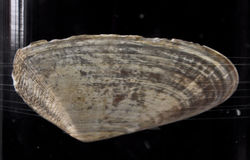|
Date & Time : 22, December 2024 17:40
General Characteristics of Mollusca
- Aquatic,mostly marine, very less fresh water forms.
- Body is soft,unsegmented,bilaterally symmetrical and divisible into head,foot,mantle and visceral mass.
- Head is distict bearing mouth,eyes and tentacles.
- Muscular foot is present in many forms.
- Pharynx contains a rasping organ,the radula.
- Gills or ctenidia are present in most of molluscs. They are provided with the osphradium.
- Metanephridia are present.
- Sexes are usually separate but some are hermaphrodite.
Classification of Mollusca
A Few Examples
1. Chiton
Habit and habitat: Chiton is a sluggish, marine animal found attacked to the rocks.
IDENTIFING CHARACTERS
1. Body is elongated, bilaterally symmetrical and dorsa- ventrally compressed.
2. It consists of shell, foot, mantle and the visceral mass.
3. Shell composed of a series of eight calcareous pieces.
4. Foot is flat and ventral.
5. Mouth and anus are at opposite ends.
6. Head is not distinct. Eyes and tentacles are absent.
7. Mantle covers the main part of the body and covered the shell plates.
8. Foot is ventral, muscular with a flat sole exe whole extending along the length of the body.
2. Pila
COMMON NAME: apple snail
Habit and habitat- Pila globosa is commonly found in pond, tanks.
IDENTIFING CHARACTERS-
1) Pila is soft bodied animal is enclosed in a shell.
2) Shell is spirally coiled round an axis called the collumella and opens outside by the mouth or aperture.
3) Operculum is well developed and close the aperture or the mouth of the shell.
4) Soft body consist of head, foot and visceral mass.
5) Foot is muscular and flat and serve for creeping.
6) Head lies on the upper side and bears two pairs of contractile tentacles.
7) Visceral mass consists of the main organs of the body.
8) Visceral mass is spirally coiled and covered by mantle to pallium.
3. Dentalium
COMMON NAME: tusk shell
HABIT AND HABITAT: Dentalium is marine and found in the sand at the depth.
IDENTIFING CHARACTERS-
1) Body is bilaterally symmetrical and enclosed in a tubular shell open at both end.
2) soft body of the animal is enclosed in a shell.
3) Body consist of head, foot, mantle and visceral mass.
4) Foot is long and conical, protrudes through the anterior opening of the shell and is used in burrowing.
5) Anus lies behind the base of the foot.
6) Radula is well developed.
7) Gills are absent.
8) Vascular system is poorly developed without distinct head.
9) A pair of nephredia is present.
10) Eyes absent and Oocytes present.
4. Limax
COMMON NAME: gray slug
HABIT AND HABITAT: Limax is terrestrial and cosmopolitan in distribution, founf in gardens and places of damp soil.
IDENTIFING CHARACTERS-
1) Body is elongated, divisible into head,foot and visceral hump.
2) Head consists of retractile tentacles (2 pairs) posterior of which have blck eyes at tips.
3) Mantle present only at anterior portion in form of a shield.
4) Foot is well developed, blunt in front and tapering at back.
5) Shell is internal,thin and rudimentary,present inside mantle.
6) Pulmonary aperture lies on right side of mantle.
7) Gills are absent.
8) Hermaphrodite.
9) Nocturnal and herbivorous.
5. Unio
COMMON NAME: fresh water mussel
HABIT AND HABITAT: Unio is found at bottom in ponds,lakes,streams and rivers burried in sand or mud.
IDENTIFING CHARACTERS-
1) Body is soft,bilaterally symmetrical and flattened enclosed in a calcareous shell.
2) Shell consists of two equal pieces or valves covering right and left side of body.
3) Mantle consists two lobes corresponding to two valves of shells.
4) Foot is well developed, large , muscular and used for burrowing.
5) Muscles well developed, responsible for closing and opening of valves.
6)Inhalent and exhalent siphons are present.
7) Two bipectinate gills preset.
8) Sexes are separate.
9) Indirect development through glochidium larva.
6. Sepia
COMMON NAME: cuttle fish
HABIT AND HABITAT: Sepia is a marine form,found in shallow waters and cosmopolitan in distribution.
IDENTIFING CHARACTERS-
1) Body is bilateraaly symmetrical, divisible into head,neck and trunk.
2) Head consists of large eyes(1 pair) and arms(5 pairs) which are found around the mouth.
3) Four pairs of arm are short,stout and have four longitudinal rows of sucker on inner flat surface.
4) Fifth pair of arm called tentacles,are long and narrow and have sucker only on free ends.
5) Shell is internal,thin and present in shell sac on upper surface of mantle.
6) Trunk elongated and shield shaped, has lateral fin around it.
7) Mantle is thick and muscular,enclosing a large mantle cavity.
8) Pear shaped Ink sac present on posterior ventral surface.
9) A pair of gills on each side of mantle cavity is present.
10) Sexes are separate, fourth arm in male is hectocotylised.
7. Patella
COMMON NAME: True limpet.
HABIT AND HABITAT: Patella is sluggish and marine, found attached to the rocks.
IDENTIFING CHARACTER :-
- Body-small and oval , elongated and bilaterally symmetrically segmented.
- Shell-oval and rounded without operculum.
- Head- bears a pair of snout, sensory tentactles and eyes.
- Teeth- very few, but hooked.
- True mantle cavity is restricted anteriorly.
- Gills- gills or ctenidia have disappeared.
- Foot- ventral, broad and flat used for creeping and adhering.
- only single auricle in heart.
8.Neopilina

|